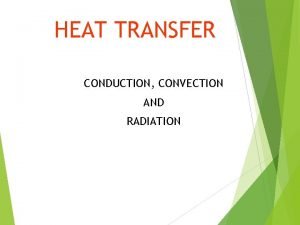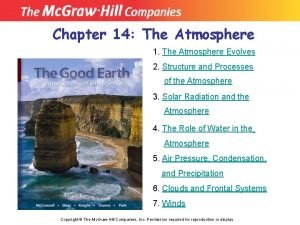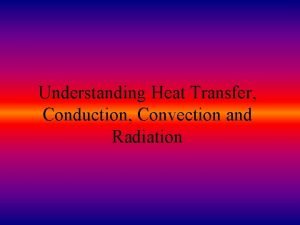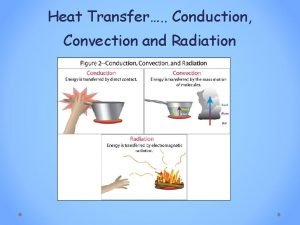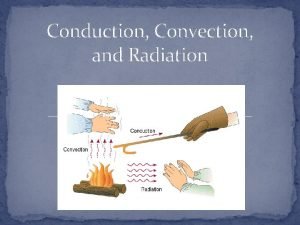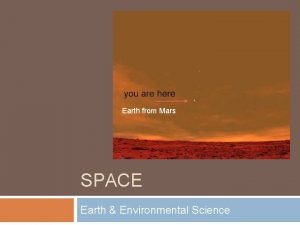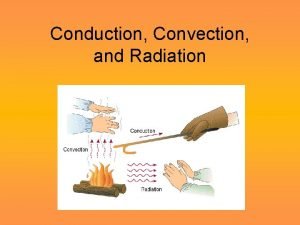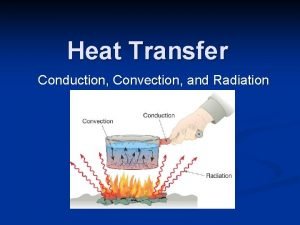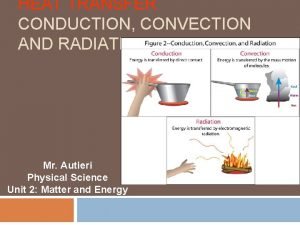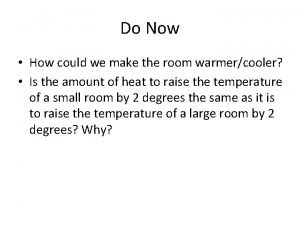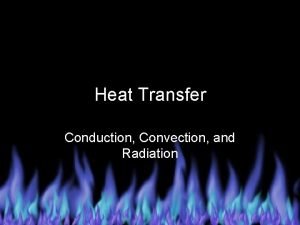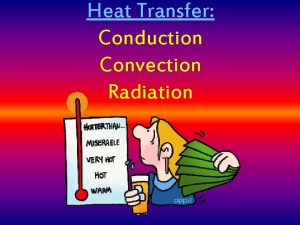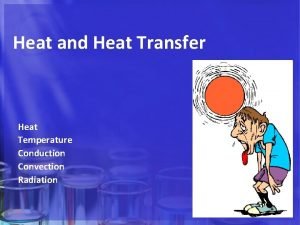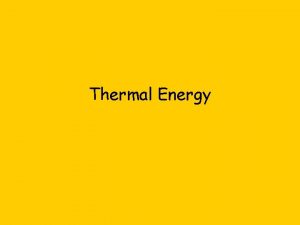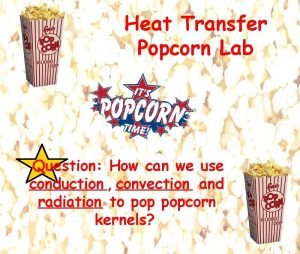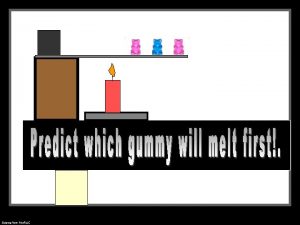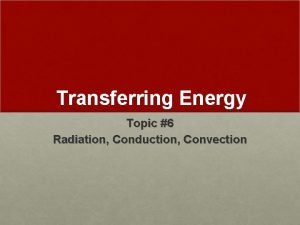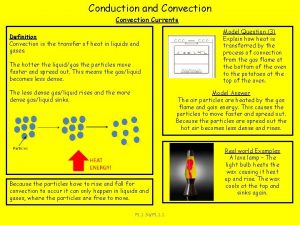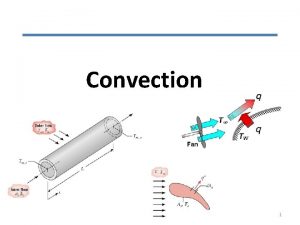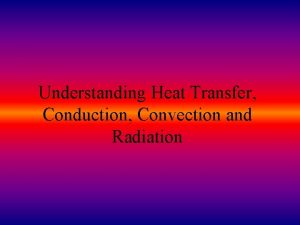Section 2 Conduction Convection and Radiation Conduction convection

















- Slides: 17

Section 2: Conduction, Convection, and Radiation Conduction, convection, and radiation are three ways to transfer energy.

Essential Questions • What are conduction, convection, and radiation? • How do thermal conductors differ from thermal insulators? • How are thermal insulators used to control the transfer of thermal energy? Copyright © Mc. Graw-Hill Education Conduction, Convection, and Radiation

Conduction is the transfer of thermal energy by collisions between particles in matter. • Remember, particles are in constant motion! Copyright © Mc. Graw-Hill Education Conduction, Convection, and Radiation

Collisions Transfer Thermal Energy Conduction transfers thermal energy from warmer areas to cooler areas. • Kinetic energy is transferred Copyright © Mc. Graw-Hill Education Conduction, Convection, and Radiation

Thermal Conductors Thermal energy transfers faster by conduction through solids and liquids than through gases. The best conductors of thermal energy are metals. • • In a piece of metal, there are electrons that are not bound to individual atoms, but can move easily through the metal. Collisions between these electrons and other particles in the metal enable thermal energy to be transferred more quickly than in other materials. Copyright © Mc. Graw-Hill Education Conduction, Convection, and Radiation

Convection is the transfer of thermal energy through a fluid by the movement of warmer and cooler fluid from place to place. • Liquids and gases can flow and are classified as fluids. Copyright © Mc. Graw-Hill Education Conduction, Convection, and Radiation

Convection When convection occurs, more energetic particles move from one place to another due to differences in density. • As the particles move faster, they tend to be farther apart. – A fluid expands as its temperature increases. • When a fluid expands, its volume increases, but its mass doesn’t change. As a result, its density decreases. Copyright © Mc. Graw-Hill Education Conduction, Convection, and Radiation

Convection Currents Differences in density within a fluid drive convection. • Warmer, less dense portions of the fluid rise • Cooler, denser portions of the fluid sink. • Think of basements or attics in the summer… Copyright © Mc. Graw-Hill Education Conduction, Convection, and Radiation

Deserts and Rain Forests Earth’s atmosphere is a fluid. • The atmosphere is warmer at the equator than it is at the North and South Poles. • Moist, warm air near the equator rises. As it rises, the air cools and loses moisture, which rains on the equator. • The cooler, drier air sinks back to the ground north and south of the equator, forming desert zones. Copyright © Mc. Graw-Hill Education Conduction, Convection, and Radiation

Radiation The transfer of energy by electromagnetic waves. Almost no matter exists between Earth and the Sun, Sun’s energy reaches Earth by radiation— Copyright © Mc. Graw-Hill Education Conduction, Convection, and Radiation

Radiation and Matter When radiation strikes a material, energy is • absorbed • reflected • transmitted The amount of energy absorbed, reflected, and transmitted depends on the type of material. • Materials that are light-colored reflect more radiant energy, while dark-colored materials absorb more radiant energy. • When radiant energy is absorbed by a material, thermal energy of the material increases. Copyright © Mc. Graw-Hill Education Conduction, Convection, and Radiation

Radiation in Solids, Liquids, and Gases In a solid, liquid or gas, radiant energy can travel through the space between molecules. Copyright © Mc. Graw-Hill Education Conduction, Convection, and Radiation

Controlling Heat Almost all living things have special features that help them control their thermal energy. Example: • • The seal’s thick coat helps keep it from losing thermal energy. This helps them survive in a climate in which the temperature is often below freezing. The scaly skin of the lizard has just the opposite effect—it reflects the Sun’s rays and keeps the animal from becoming too hot. Copyright © Mc. Graw-Hill Education Conduction, Convection, and Radiation

Thermal Insulators A material through which thermal energy is transferred slowly is an insulator. • Good Insulators: wood, some plastics, fiberglass, and air. • Metals are poor insulators. • Gases, such as air, are usually much better insulators than solids or liquids. • Some types of insulators contain many pockets of trapped air. These air pockets conduct thermal energy poorly and also keep convection currents from forming. Copyright © Mc. Graw-Hill Education Conduction, Convection, and Radiation

Insulated Buildings • • Building insulation is usually made of fluffy material, such as fiberglass, that contains pockets of trapped air. The insulation is packed into a building’s outer walls and attic, where it reduces the flow of thermal energy between the building and the surrounding air. Copyright © Mc. Graw-Hill Education Conduction, Convection, and Radiation

Thermoses A thermos bottle reduces thermal energy transfers into and out of the liquid in the bottle, so that the temperature of the liquid hardly changes over a number of hours. • To do this, a thermos bottle has two glass walls. • The air between the two walls is removed so there is a vacuum between the glass layers. • Because the vacuum contains almost no matter, it prevents thermal energy transfers by conduction or convection between the liquid and the air outside thermos. Copyright © Mc. Graw-Hill Education Conduction, Convection, and Radiation

Review Essential Questions • What are conduction, convection, and radiation? • How do thermal conductors differ from thermal insulators? • How are thermal insulators used to control the transfer of thermal energy? Vocabulary • conduction • convection Copyright © Mc. Graw-Hill Education • radiation • thermal insulator Conduction, Convection, and Radiation
 Which is the best surface for reflecting heat radiation
Which is the best surface for reflecting heat radiation States of matter diagram
States of matter diagram What is heat transfer conduction convection and radiation
What is heat transfer conduction convection and radiation Convection examples
Convection examples Venn diagram of conduction, convection and radiation
Venn diagram of conduction, convection and radiation Radiation heat transfer
Radiation heat transfer Radiation travels in straight line. (true/false)
Radiation travels in straight line. (true/false) Whats conduction convection and radiation
Whats conduction convection and radiation Convection conduction radiation
Convection conduction radiation Two examples of conduction
Two examples of conduction How are conduction convection and radiation alike
How are conduction convection and radiation alike Convection and radiation
Convection and radiation Following charting convection used in work study
Following charting convection used in work study Whats conduction convection and radiation
Whats conduction convection and radiation Type of thermal energy transfer
Type of thermal energy transfer Temperature,conduction,convection, radiation
Temperature,conduction,convection, radiation Bellringer conduction convection or radiation
Bellringer conduction convection or radiation We transfer
We transfer



